J
EN BERVIN IS AN ARTIST and maker of poems without boundary or limit. Her poetry is a poetry of connections, threads, weaving, words born of sound and image, of history, text from textile, textile from text. Her poetry emerges in art venues, artists’ books, public performance, silk film, and it is fabricated with typewriters, sequins, thread, ink and, soon, nanotechnology.
I will not forget the first time I saw her Dickinson Fascicles, large-scale, wall-size embroideries of the punctuation and markings found in the hand-stitched booklets that Emily Dickinson made for her poems. I leaned in close to the fabric on the wall, my eyes riding the twitching rhythm of the marks across the batting, but also the minuscule rising and diving within each mark, stitch by stitch. I raised my hand instinctively, perhaps as a conductor would before a score, and paused, imagining the texture of the text on the tips of my fingers. Then I traced in the air those gaps and spans where there was nothing at all.
But there’s always something. Even white space, Bervin has said, citing John Cage, is musically scored. In Nets, her book of erasures of Shakespeare’s sonnets, she wrote, “When we write poems, the history of poetry is with us, pre-inscribed in the white of the page; when we read or write poems, we do it with or against this palimpsest.” Her work—at the intersection of writing and weaving, text and textile, song and silence—makes luminous that which we hadn’t noticed or, until she showed us, been able to see.
Her current—and most ambitious—project, the Silk Poems, is an experimental book (if “book” is defined loosely) that takes silk, in Bervin’s words, “as its subject and form, exploring the cultural, scientific, and linguistic complexities of silk, mending, and the body through text and images nanoimprinted on transparent silk film.” If you were to hold up a piece of this translucent material, what would it look like? What might you see? Very little at all—until you shine fiber-optic light through it. Then the words and pictures would jump up, projected into bloom. Here too, embedded within the high technology, history pulses: 5000 years of culture, art, and writing, of poets, traders, emperors, laborers. The history and the silk itself almost invisible, until illuminated.
While most of us think of silk as something we might wear, scientists regard it as much more than that. They’ve recently begun unlocking its remarkable properties, some of which could eventually have widespread high-tech and biomedical uses. Bervin believes that poetry has work to do in the world. With silk film, that work travels beyond the library or classroom, beyond books and academia, and into laboratories—even, potentially, into our own bodies. Bervin’s work shows us that every trace, every thread matters, every mark, every last letter, everything we hide and everything we reveal, that art and poetry are made of our intentions, and that we are too.
In Souls of the Labadie Tract, Susan Howe describes how, two hundred and fifty years ago, the theologian, pastor, and writer Jonathan Edwards traveled between parishes in Western Massachusetts by horseback, writing as he rode and pinning those notes— scraps of paper fashioned from silk or other some other salvaged fabric—to his clothing, “fixing in his mind an association between the location of the paper and a particular insight.” He would arrive at his destination dressed in words. Today words needn’t only clothe us; they may quite literally enter and become a part of us. With the right light, poetry rises through and from the page, rises to the walls, and signals and shines beneath our skin.
* * * *
Although her Silk Poems research has her traveling widely and often, Jen Bervin and I were able to talk at length on the phone in early January 2015, which is where the bulk of the interview below has its origins. We continued editing, revising, and refining over a series of follow-up emails. I have known her for about four years now, and no matter the medium—online, on the phone, or in person—Jen is unfailingly generous, kind, engaging, and gracious. She laughed often throughout our conversation and conveyed an infectious enthusiasm about her work and writing/making art in general.
Jen Bervin (JB): Earlier you asked me about where I was and whether I was writing poems for the Silk Poems project already.
Darren Higgins (DH): Yes.
JB: Right now I am thinking more about content and forms—really the overall structure. But one of the things that I have been doing as I research is trying to realize when components of the research get too big and should be diverted into their own thing. That has amounted to some very exciting thinking.
I knew that the research would lead me in some wild directions, but one of the treasures that I came across in Suzhou, China, was a woven replica of a poem composed in the fourth century B.C.E. by a Chinese woman poet, Su Hui. It is written in a reversible form she invented—a 29 x 29 character grid that can be read in any direction, yielding thousands of possible poems. Moreover, she wrote it in five colors and embroidered the poem in silk.

There is very little written about the poem in English. David Hinton translated one quadrant of it under the title “Star Gauge” and has a useful essay on it, “Welling Out of Silence.” The best work on this poem I’ve been able to find is by the French poet, Michèle Métail, who wrote a whole book on it: Le vol des oies sauvages. So I was trying to read about the poem in French, which is pretty slow going.
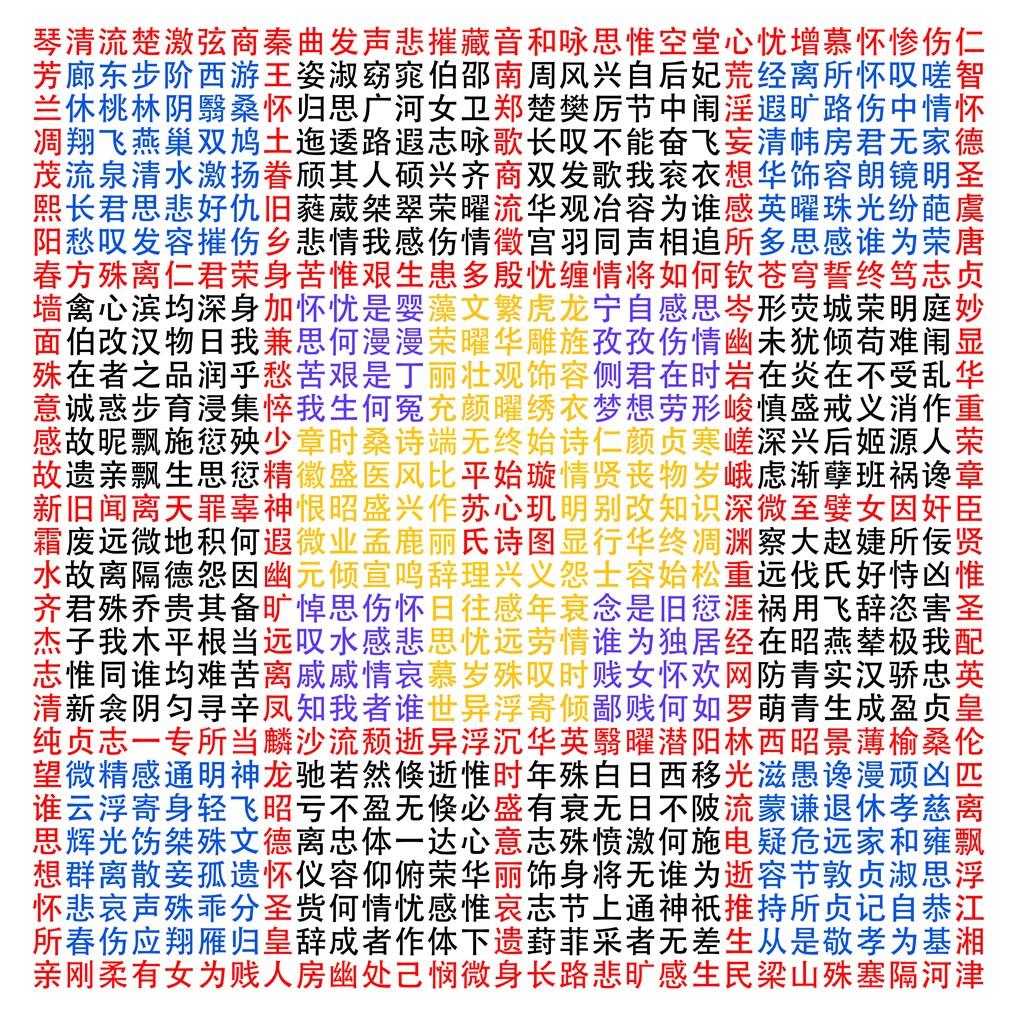
When I was in Italy on the Bogliasco Fellowship this past fall, I started hashing out a rough translation of it with substantial help from the dancer in residence, Mei-yin Ng. I was spending a lot of time looking up definitions of words but, seriously, you come across single characters that have up to 70 meanings.
DH: How many?
JB: Seventy, seven-zero.
DH: My god.
JB: You can imagine, as a non-native speaker of Chinese, the translation problems it starts to pose. To add to the mess, the poem was written in complex Chinese characters and now it’s typically presented in simplified Chinese characters, which are slightly different, so that’s when I lost it in Italy. I thought, “Oh my God, I’m translating it from the simplified Chinese. I’m not even translating from the right alphabet yet.”
DH: Must have been incredibly frustrating…
JB: I’d been at it for quite a while. Not to mention the fact that a Chinese character can act as any part of speech, depending on context, and the meaning of the character changes according to the character next to it. If you’re coming to that character from all different directions, the meanings are very much in flux. It’s an infinite poem, essentially. I felt both so thrilled and daunted by it and also somewhat appalled that there was just so little written about it. That there was this treasure written by a woman so early on, the complexity of which we really haven’t matched today, and it’s not a well-known thing!? That was shocking to me.
DH: Hard to believe.
JB: Like with any big, delicious problem I started to think about what could be done. And like with any big, delicious problem in art I took a lot of wrong tacks looking for something that works, but what it has come down to now is really beyond thrilling—some real progress. I think that Jody Gladding is going to translate the Michèle Métail book, so that whole book could, in some form, be available in English to English-speaking audiences. The book goes into not only the complexity of the reading patterns and how you might structurally read it but also the celestial maps that influence the structure of the poem, and it talks about a lot of poems that came out of Su Hui’s work and were influenced by it.
Now we’re just figuring out where it might go publication-wise. Hopefully we can lure David Hinton back into trying to translate the rest of the poem. You can imagine that it’s quite a task—a task that could be done thousands of times over with different results!
DH: Unending possibilities.
JB: Right. But the thing that seemed most exciting to me was to have the experience of time in that poem, and to keep the textile aspect of it in the foreground. I can’t read Chinese, so I thought, well, for me to embroider it would be a craft, not a reading experience. This is when something very special that I encountered on my research trip, in the same city where I encountered the facsimile of that poem for the first time, came back to me—the Suzhou Embroidery Research Institute.
This is a place where highly, highly trained embroiderers make these double-sided works that can be viewed from either side, so it’s essentially a reversible image. These embroideries take a couple of years to make and I thought that it would be really exciting for me to commission embroideries of this poem, after first building a relationship with a few embroiderers at the institute who have an interest in reading poetry. And then, through conversations, writing, and film, we would track the experience of the embroiderers—of their relationship to the poem—and let that be its translation too.
DH: Adding another layer of translation (and meaning). In this case, a translation of experience as well.
JB: Yes. The important part of that work is the experience of the embroiderers’ journey with that poem. That’s what is exciting to me.
DH: You’ve been working on this Silk Poems project for a while now. When did this new plan start to come together?
JB: Well, none of it would have happened without the Creative Capital Grant in 2013—I’ll never cease being thankful for that one. We visited China around the beginning of November 2013, and I’ve been talking about that Su Hui poem non-stop ever since. The whole solution came slowly, first with begging Jody to translate the Métail book. I was just trying to read the book in French for awhile. I soon realized that it was becoming a question of what I need for my research vs. what I would hope would be available to a lot of other people.
DH: That seems like a crucial distinction. Can you talk more about that last point?
JB: I think that’s where a lot of these decisions were coming from—I could spend a lot of time in this Su Hui poem trying to translate it, but I don’t feel confident (given that I’m not a Chinese translator and this is one of the most difficult translation projects imaginable) that I could bring that experience to other people in a way that’s as meaningful as the idea to collaborate with an embroider at the research institute. I could point to that collaboration as a kind of solution to get other people interested in working on it again.
I’m a big fan of the joyful solution and that really feels like one…so that happened within the last month or two.
DH: This poem has an interesting back story: Su Hui’s husband, a government official, took a concubine, which infuriated Su Hui. He soon after left for a distant post with this mistress. Su Hui refused to go, but it’s said that she grew to miss him and composed the poem to win him back and call him home. According to the story, it worked. He dismissed the concubine and rejoined Su Hui.
JB: The story is quite compelling, and it is mostly what gets discussed—the story of the poem. That she sent this poem as a letter obviously has a lot of resonance for me with the Dickinson envelope poems. Su Hui’s intended audience for the poem, and her intended purpose as well, is quite singular and yet the poem everything but—it’s infinite. It’s easy to fall into the trap of speculating about a writer’s life instead of focusing on her work, and this is too often the case with women artists and writers. When a lot of translations of the poem exist and Su Hui’s work is getting tons of attention, I won’t need to have this redirecting bent. I look forward to that.
DH: There is so much here. It’s the kind of project you could play with for the rest of your life, essentially.
JB: Yes. But I think that for the sake of the Silk Poems, the nano-imprinted silk film, to simply reproduce the Su Hui poem is enough. You lose the five colors because it’s not a color format. But simply to have it present and to allow its structure of reading to help me think about how other things appear or inform how they are read—that idea of reversibility, which was already in the silk poem, coming out of the DNA structures and writing forms related to the structures—has already done its work.
DH: Hearing you talk about reversibility makes me think of how you’ve always paid attention not merely to the front of a piece, the part we might most readily see, but the flipside as well, as in The Desert. That play between the seen and unseen, the possible and the revealed… it comes up again and again, now that I think about it. In Nets, your words float to the surface in pools of Shakespeare’s sonnets. In the Dickinson Fascicles, you highlight markings, symbols, twitches. In the Gorgeous Nothings, you and Marta Werner bring scraps and torn envelopes and variations to the fore. Do you see this interest playing out in the Silk Poems? Perhaps in how you want to record the experience of the embroiderer as another form of translation?
JB: Absolutely. Just as you said.
DH: So, what has all this new thinking done to your original concept for the project?
JB: If anything it’s just a huge relief. I feel like in our practice one of the most difficult things is coming to the right framing of something that’s really exciting to everyone, and once that’s in place, the work becomes very easy and fluid. It’s when you’re stuck in that purgatory I was in with that poem that things are complicated.
I think of myself as a giant digesting machine for all of this, and I’m just so relieved when something becomes that clear.
DH: You don’t seem to panic, or at least not outwardly, when you are having doubts or collecting endless amounts of information without a sense of where it’ll lead.
JB: The thing is I panic but I’m talking with everyone about that panic. One of the things that I really wanted with the Silk Poems in particular was exactly that aspect, that I couldn’t figure out almost any of it alone, and that it was something that I was going to have to keep talking about with lots and lots and lots and lots and lots of people to get anywhere interesting, both in the research and in the development of the project.
I really love that idea that you can’t make a work alone. I question the idea of single authorship in general, but especially in a work that has and draws from such a complex history and such a complex presence in a sense.
With all the scientific development in this work, the historic wealth of information about silk, and art and literature that draw from silk, the too-muchness of it was a known problem to begin with.
DH: So it was built in from the start that you’d interact and collaborate with people from different disciplines, different industries even, across the world?
JB: Yes. I think also I wanted to get much more comfortable feeling out of my element in every way.
DH: How so?
JB: If you walk into a bioengineering lab where they are developing new uses for silk, you pretty much don’t know anything. You just have to enjoy the place of asking a ton of questions about it and continuing to ask those, and not being embarrassed about having to race up to speed every time you enter.
DH: What’s appealing or exciting about that to you?
JB: I’ve always felt like it’s a trap in the arts to get comfortable in your work. I think naturally we revert to ways of thinking pretty readily. I’m guilty of that, but I think if you choose things that make doing that pretty impossible, then it puts you in some good spaces to learn and explore. I am excited about making something that doesn’t look like anything else I have made and has a process that doesn’t resemble any other process I have worked with before.
DH: When did you first realize that this is the way that you enjoyed working?
JB: I didn’t say I enjoyed it! I said that I wanted to work that way. I think by nature I am very shy and I’m also very curious, so that’s something I have to live with in the world. It’s not necessarily comfortable to go about things this way, but it certainly is interesting. Does that make sense to you?
DH: It does. I know, from being an inherently shy person myself, that there’s a certain jolt in saying yes to an idea or proposal that makes me uncomfortable. It’s frightening but thrilling. There’s productive energy in that discomfort.
JB: I would say I’ve been super-lucky in that Charlotte Lagarde, my partner, was willing to work and travel with me and to photograph and film places we went for research—not with the aim to make a film about the Silk Poems but to give me a way to keep growing from the research after the fact, because you can’t re-do a lab visit on the other side of the world. You might only get that access once, so to have a record of what people are saying and how they are saying it and what they are showing you in real time is indispensable. That was a huge shift. I had never thought about working on a poem that way. I’ve never needed photo and video, for years throughout a process, to research something. It’s been humbling to try to communicate what you need to someone else when you’re generally very private about it.
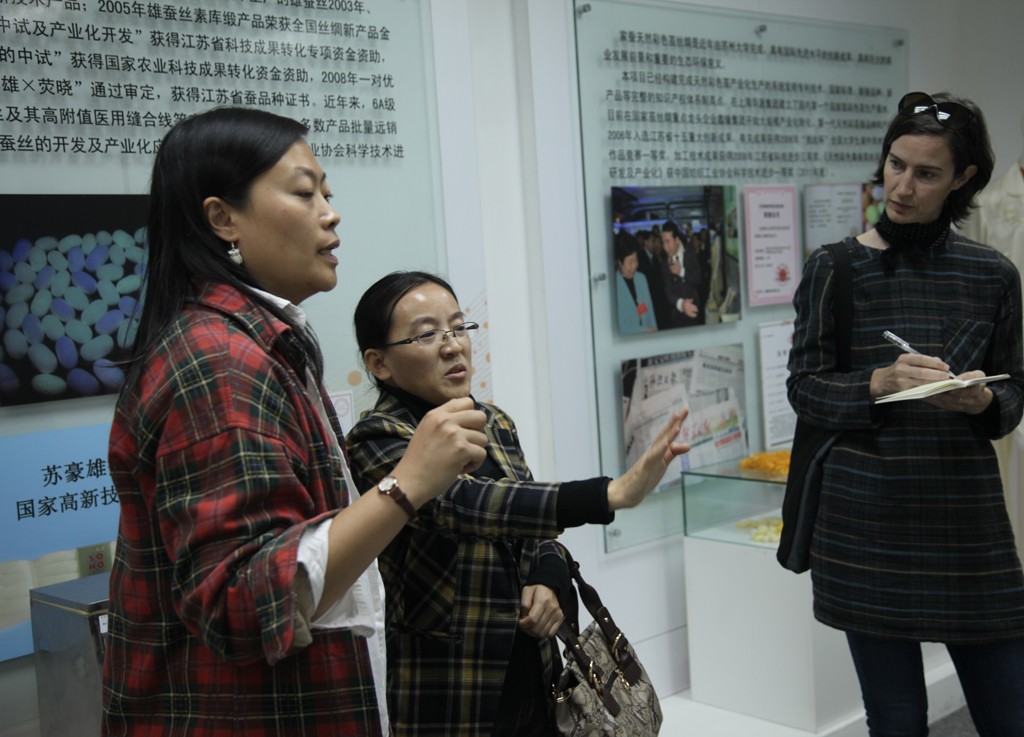 Huang Haisu and Dr. Tieling Xing with Jen Bervin at Soochow University
Huang Haisu and Dr. Tieling Xing with Jen Bervin at Soochow University
DH: How do you keep yourself from being overwhelmed by all the information and everything you’re taking in?
JB: I think I try not to have too many expectations about what I’m going to experience or understand. I guess I could compare it to going to a library in search for a particular book and then finding one in that same row that you needed far more and wouldn’t have found on your own. It’s often that thing to the side of the thing that I’m actually looking for that turns out to be meaningful. Getting too fixated on coming away with a particular thing or looking for a particular thing doesn’t help me be aware of what the potentials are in the moment.
It’s important to be able to admit defeat and keep looking around, do you know what I mean?
DH: That’s true of writing itself, isn’t it? Seems like whenever I start a poem or essay with an idea of what I think I mean or want to say, I wind up, by the time I’m done, in a completely unexpected place, with completely unexpected words on the page. I love that. Discovery and surprise. What a rush—it’s almost magical. The poem finds and determines itself.
Part of it must be opening yourself up, exposing yourself. You let go of intention, which leads to things you wouldn’t have figured out had you held strictly to your plan…and leads to these discoveries that couldn’t have happened otherwise.
JB: Absolutely. I think your essays read that way.
DH: I certainly experience them that way. I find out a lot of what I actually think by going through the process of writing.
JB: I think that’s why it’s so enjoyable to read them.
DH: That’s kind of you to say…
JB: I also love that this work is leading to collaboration with people that I deeply, deeply admire. This matters to me—and has for a long time. It’s just becoming more and more overt.
DH: Did Charlotte’s recording of your travels, your research, play at all into your idea of documenting the embroiderers’ experience with the poem?
JB: Yeah, absolutely, because I have been looking at the videos she made at the embroidery institute in Suzhou for two years now. It’s just so exciting to watch the technique—and the environment in which people are embroidering is quite special. The workshop itself is beautiful and full of light. I love how layered the work sites are. You have a skull-and-crossbones cloth where someone might put their elbow and a cell phone a little farther down and then particular ways each embroiderer organizes their thread color palette and their work area, you have tea on the window sill. It’s a joy to be in that space. I was taken through it on a tour during which I was rushed along and still I have that sense of the richness of slow time there.
DH: That’s beautiful: “the richness of slow time.” Has that sense always been with you? Maybe you can talk about how you came to work with textiles in the first place, and how that intersects with your poetry.
JB: I grew up in a family of women who sew. My mother sewed clothes for us, my grandmother sewed clothes for her family, and I learned pretty early on. My mom was great about teaching me how to do a lot of different things, how to do some basic sewing and how to work with pattern and that kind of thing. Before I even really got underway in the visual arts I was already involved in sewing and the culinary arts for sure. Those things developed in step with reading. I don’t think I really would have considered myself a writer until I was pretty far along in my 20s even, late 20s to early 30s.
I came to writing from the visual arts. I was feeling uncertain about what art could do and how it could do it in the art world, along with a desire to really learn how to articulate complex thoughts in the medium of language, which is what I think poetry does best. I didn’t know how to do that yet. As I was finishing up my degree at the School of the Art Institute of Chicago it became really important to me to slow down and make work that I wanted to live with.
It’s a lot like this translation tangle I got myself into. A lot of great things in the arts come out of a sense of discontent or disgust or failure or inadequacy, so it’s a such useful feeling in the arts, if you let it be useful.
DH: That could take some practice though, letting it be useful.
JB: Yeah. I think that I was really lucky to have a family that left me alone. It gives you privacy about your failures. Because you have time to just be comfortable with them.
DH: There’s a bumper sticker: “More parents should just leave their kids alone…”!
JB: Yeah, that’s not a popular parenting recommendation…
DH: No.
JB: And I’m in no position to recommend, but I really appreciated that.
DH: To have your own space to work through what you needed to work through?
JB: Yeah, and just to…I don’t know. I think it fostered a confidence in myself that early on made me comfortable in discomfort. Maybe too comfortable in discomfort, I don’t know.
DH: I guess that’s a danger. I hadn’t thought of that…
JB: The jury is still out. I’m just so pleased that I’ve become more of a social animal as I’ve aged. I didn’t see that coming. I was a little worried I’d be more of an Agnes Martin loner type, so that’s been a nice surprise.
DH: What do you think is responsible for this evolution?
JB: I guess I had had enough time alone. When I was at that juncture between art and writing, I worked as a fire lookout and that’s pretty isolated work. I think for some people it sounds really awful but to me it was just heaven. I was learning Latin, reading, embroidering, writing, hiking, etc.—with a view to die for and some wonderfully amusing chatter on the Forest Service radio to monitor. As a lookout, you spend all day reading landscape—and I love that landscape: the Sonoran Desert. I kept a keen eye out for fires or “smokes,” as they call them, and had plenty to report, but the work of the lookout is mostly map-based—conveying very precise map work accurately.
I moved to the desert with a real intention to slow down and figure things out, and that willingness to be alone and to be lonely and to be uncertain for a long time gave me a grounding that never left. I just waited. I waited and I read and I wrote and I tried to figure things out.
Then when I came back to graduate school for writing and was combining the two, art and writing, it was with a very different sense.
DH: I said earlier that you never seemed to panic but I realize now that it’s more about what you just mentioned: your patience, your willingness to wait (to be on the lookout, so to speak), and yet with an underlying confidence that the answer will arrive, that you’ll find it, however long it takes.
JB: One thing I encounter a lot in conversations about interdisciplinary work, especially with writers, is the inter-genre question. I guess I’m grateful that for me it was never a hang-up. I never felt that I had to explain to anyone what I was doing. I just had to show them what I meant. I feel like anyone who encounters my work can understand what I’m doing if the work is good—and it’s not always good, but I try. If you give people the opportunity and you show them what you mean by that intersection, anyone can meet you there, but to put the genre ahead of the work often makes that seem more impossible than it actually is.
DH: And what drew you to silk? Why silk?
JB: A friend, Amanda Schaffer, wrote a really wonderful piece for Slate magazine. She was researching many different aspects of this new silk boom that resulted from David Kaplan’s discovery in 2009 of how to liquefy the silk cocoon. Once Amanda finished writing the article she was still so engaged with the ideas that she got in touch to ask if I might want to collaborate on something visual and verbal. She sought me out because she knew I was already working with text and textile and the intersection of the two. Even though the research didn’t look like other things I did, it was the same area of interest.
So it really started in the spirit of collaboration. Amanda got very busy with other projects, including a pregnancy (her second child), and as much as I tried to lure her back into the project, she’s really held her ground. But she is generous with conversations from time to time—asking the right questions, or telling me what to ask, and explaining intensely complex things to me.
I think going into the Silk Lab at Tufts with her to meet Fio Omenetto and David Kaplan in the very beginning was a real gift. Because if you walk into one lab, you get this idea that you can walk into another, so visiting the Stanford Nanofabrication Facility just feels like something I might be able to do after all, or at least like something to propose. I’m a big fan of just letting people say no, but always asking, always asking.
DH: I’m interested in the relationship of silk to the body. What role does that play in the project?
JB: That aspect of it is really important. Silk is universally biocompatible. Every single body on earth will accept it in any context, which is why the liquefaction discovery was such a big deal. It opens up a huge range of new possibilities. The bioactive silk sensor—the thing I’m working with as an imagined context—is still in the research phase.
I just want to stop the clock for a minute to say, Wow! That’s an amazing context—silk inscribed nanoscale inside the body as a visual sensor, something that would act as a harbinger, something that will alert someone, in a medical way, to a change that has occurred in the body. Obviously, it’s not a neutral thing to have an inscribed piece of silk inside of you that is showing you something potentially very bad or hopefully normal about what is most likely a really precarious health situation. So I have been interested all along in imagining how this sensor affects someone’s conception of their own health—how it affects their imagination, how what is inscribed there is affecting on other levels, deeper levels in the psyche and spirit.
That seemed like a territory that a poem could handle—and has handled—in meaningful ways. I think that in many times and kinds of difficulty we turn to poetry, and yet most of the time we act like it’s superfluous. I really believe that poems have jobs to do. Not set job descriptions, but I think we need them more than we let on.
DH: In what sense do we not admit to that, do you think, or do we fail to see the work of poetry?
JB: I’m not so focused on pointing to failures. I’m more interested in pointing to poetry and saying it’s a wellspring, because I believe that.
The poem (and by “poem” I mean visual and images I’m thinking through right now) probably isn’t going to be inside of a body. It’s going to be a silk film outside the body. Something that you can project and read with fiber-optic light as a projection on a wall. It’s content comes from the assumed context as a bioactive sensor, one that may become real and may not, but I guess the viability, so to speak, of the thing that I make (that is, whether it becomes part of a real sensor inside someone) is really not up to me.
I’ll definitely offer anything I do back to the researchers who inspired it and hope it will open up new possibilities for collaboration. What I can do is offer up a context in which a poem can be an important component of a medical development.
DH: So where do you envision the Silk Poems living, ultimately? Will they be “published” in a traditional sense?
JB: The object was always the easiest part because that’s already a given—to nanoimprint silk film—that’s been fairly straightforward, and to know in advance that it’s something one would read as a projection with light. That’s a lot of knowns for a work of art. I don’t usually start knowing what the thing I’ll make in the end is. I don’t know how many need to exist. Maybe just one. And I’ve been calling it “Poems,” which suggests a book, but I’ve imagined something more like microfiche there. I’m guessing that a reading situation for this is probably a room, not a folio. It will show me, I guess. Or other people will suggest things and show me. That’s most likely what will happen. Or the materials will suggest things.
DH: I was curious about that, how much the material or context determines the content—how much the textile determines the text.
JB: The silk film has to be nanopatterned to work as a sensor, so the scale of the writing, the surface material, the way in which it can be read, and the imagined context were all already there when I started.
DH: Right, but does silk demand a particular kind of poetry? Are there things that shouldn’t be said on the silk or things that should be said?
JB: I think there are things that I feel responsible to in a structural way, like the development of the card loom, for example. The first binary system, the first computer, so to speak. The structure of the silk itself. And the process and the forms that are involved in sericulture. All that seems very fundamental to get in the poem. I feel like there’s a danger of falling into the traps that historical novels can fall into. You can get so overwhelmed by the factual material you want to convey that the book itself suffers. I guess that’s where that sitting and waiting and standing back and seeing what things are indispensable to the work comes in.
In traveling the world to research silk—China, Japan, France, Italy, Turkey, Georgia (and more to come: India, Spain, Egypt, etc.)—what becomes increasingly difficult is how to address that kind of multilingual context well in the finished work. I mean, you can’t just bring it all into English—it’s wrongheaded. I’ve imagined translating at the very least the project description into every language that affects the project. I also hope to return to sites where I researched to share the finished work.
DH: I love that the poem will be read with light.
JB: I’m really happy with that because the way silk reflects light is one of its remarkable properties. I was just reading about how the smoothness of the fiber made it a superior embroidery material and how it really brought the craft of embroidery to Egypt and replaced wool permanently. That the material itself can change the course of what is made in a given culture, it’s quite astounding to me.
DH: We have this ancient fiber, used in so many cultures for thousands of years, and yet even today we’re still discovering its properties and finding new ways to use it. It’s remarkable.
JB: It really is.
—Jen Bervin & Darren Higgins
.
Based in Brooklyn, poet and visual artist Jen Bervin brings together text and textile in a practice that encompasses poetry, archival research, artist books and visual art. Her works involve strong conceptual elements with a minimalist’s eye for the poetic and essential. Recent books include Draft Notations (Granary Books 2014) and Emily Dickinson: The Gorgeous Nothings (Christine Burgin/New Directions) co-edited with Marta Werner, a finalist for The Poetry Foundation’s 2014 Pegasus Award for Criticism, and a Best Book of the Year from Times Literary Supplement, Hyperallergic, and The New Yorker. Her works have been shown at the Walker Art Center, The Eli and Edythe Broad Art Museum and elsewhere, and are held in more than thirty collections including the J. Paul Getty Museum. Bervin’s honors include a Creative Capital Grant, a NYFA Fellowship, and residencies from The Josef and Anni Albers Foundation, MacDowell Colony, The Camargo Foundation, The Bogliasco Foundation, and the Rauschenberg Foundation. She has taught at Poets House, University of Denver, New York University, Pratt Institute, Vermont College of Fine Arts, Harvard University, Yale University, and will be a Fitt Artist in Residence at Brown University in 2015.
—
Darren Higgins is a writer, editor, and artist living in Waterbury Center, Vermont, with his wife, two sons, and a cat who never comes when she’s called. A graduate of the Vermont College of Fine Arts, he has written poems and stories for a variety of publications, essays for a couple of local newspapers, and commentaries for Vermont Public Radio.
.
.FL
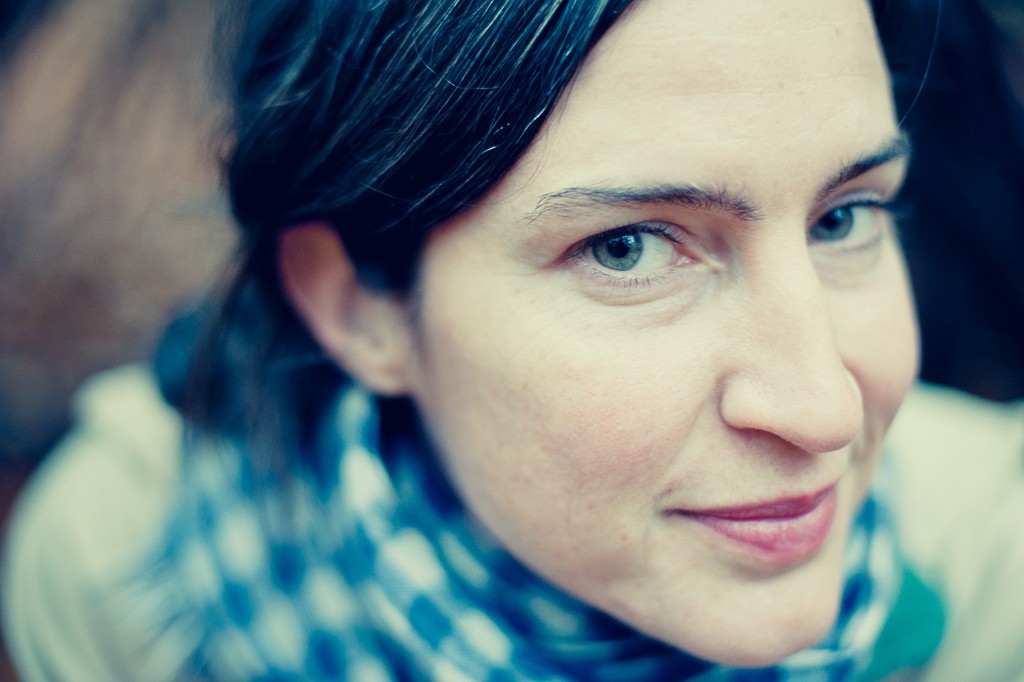
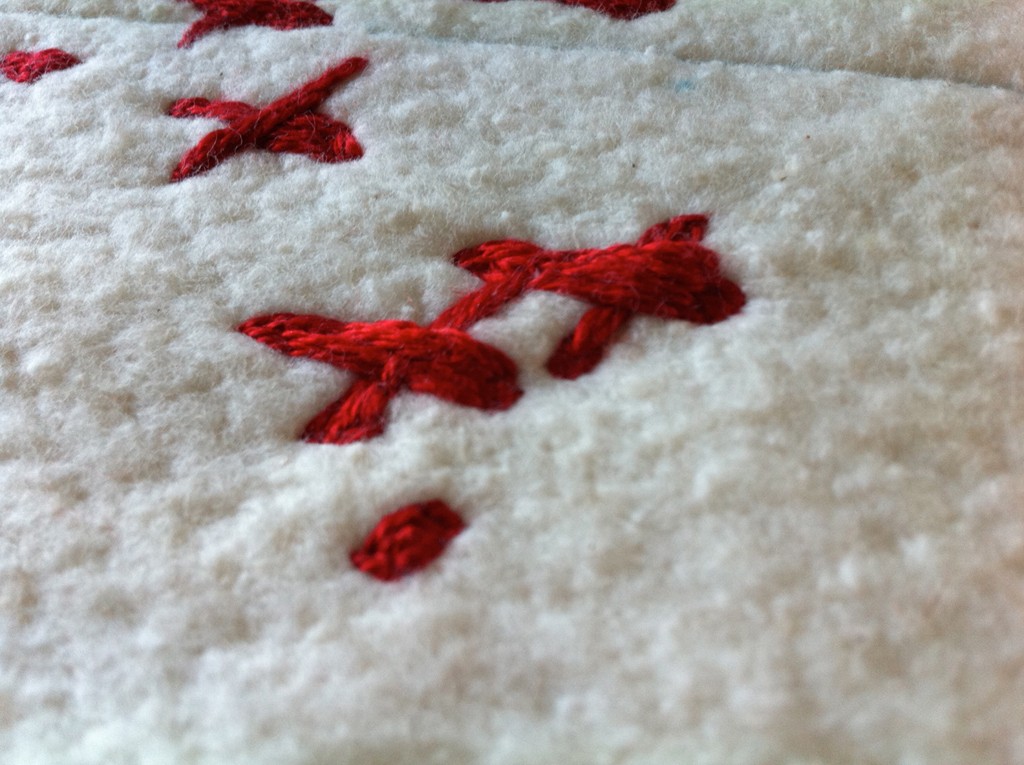
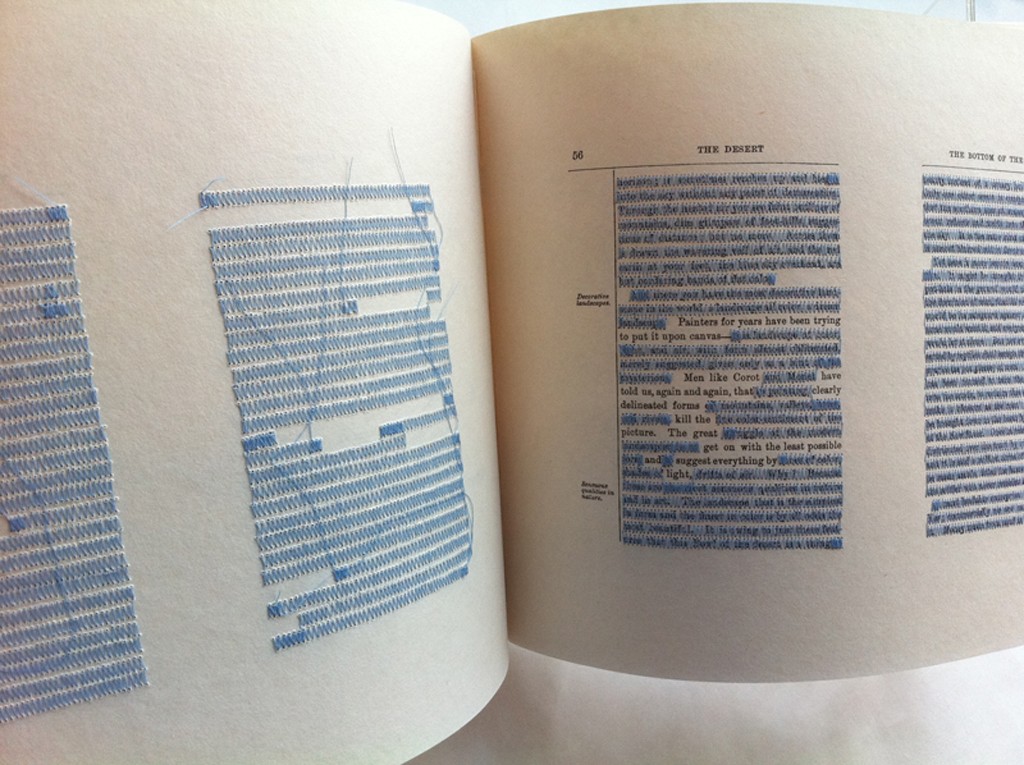
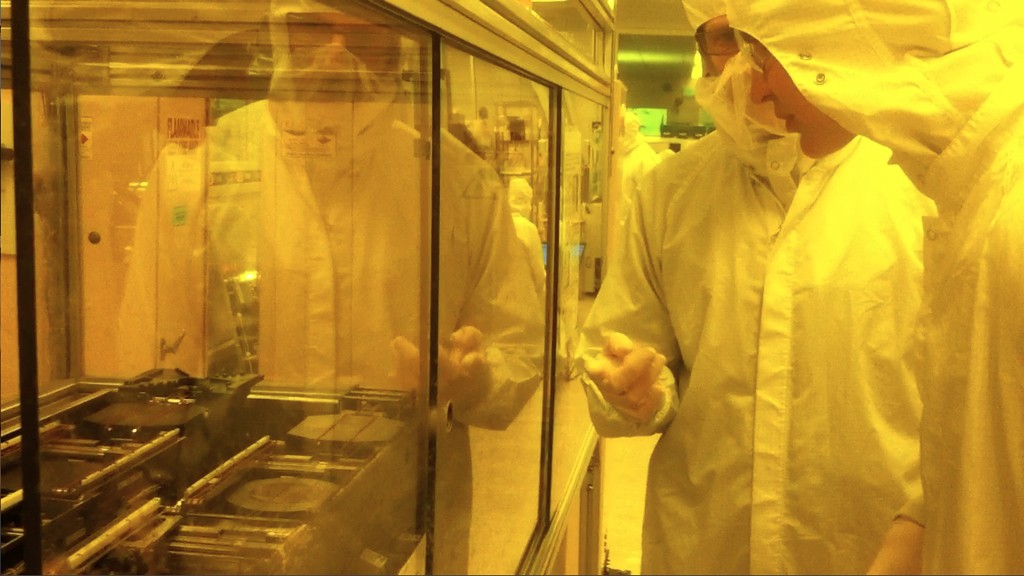
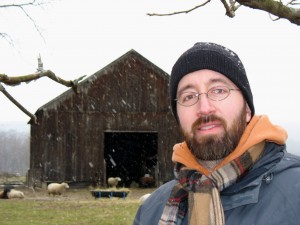
Though I don’t know Jen, I will forever picture her at VCFA with a sewing project in her lap during lectures and readings. Coming from the prose side, I found the idea of NOT making work alone frightening…and promising at the same time.Thanks for such an in-depth interview Darren.
Thank you, Hollie. Talking to Jen was an absolute pleasure. I don’t know how many times I’ve read through this interview by now, but I’m still finding new things to savor in her remarkable responses.
What a gift, this phrase, “the joyful solution” . . . I will savor it a long time. Later I will come back to this essay and find a different phrase to live with for a while . . . this will take a long time. Thank you.
Thanks, Anna Maria. Lovely to see you back!
So glad you enjoyed it, AnnaMaria.